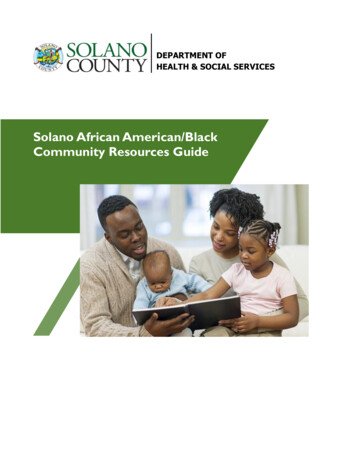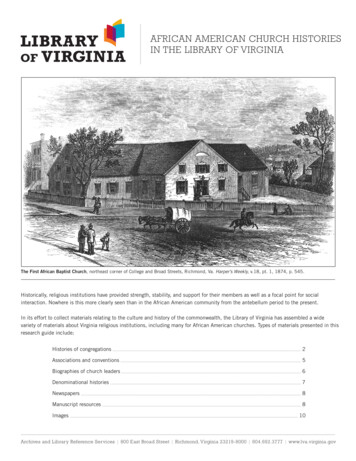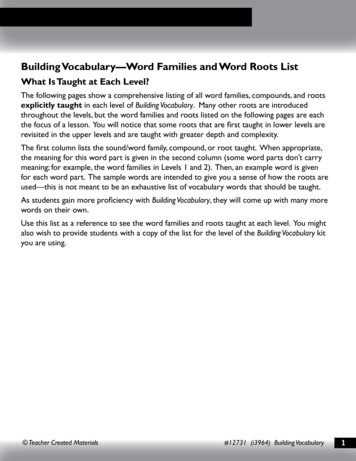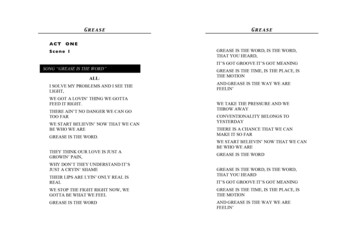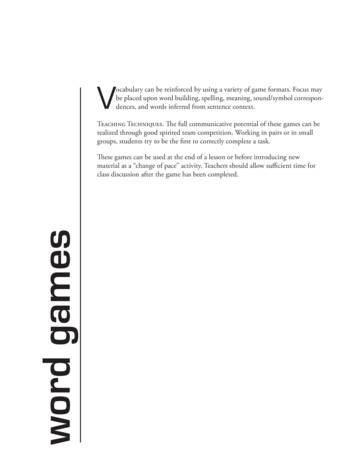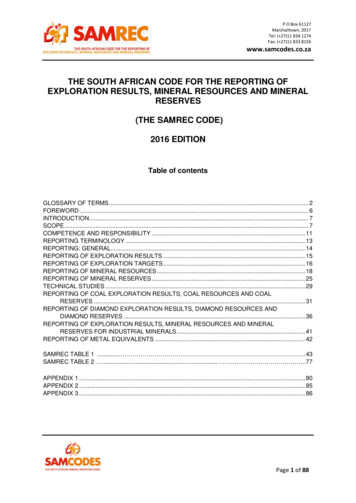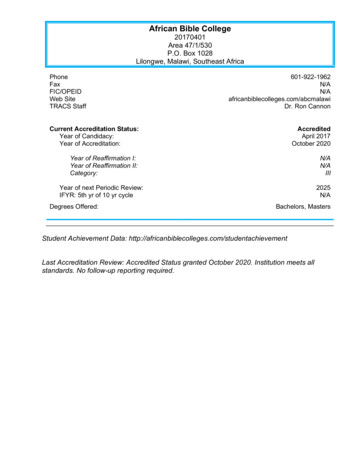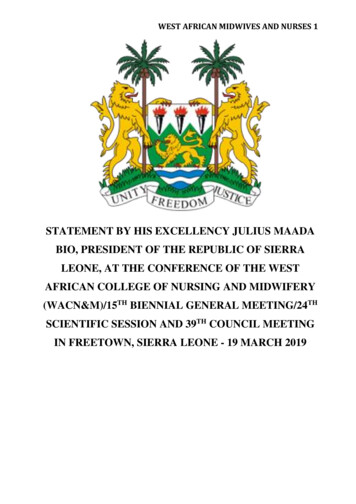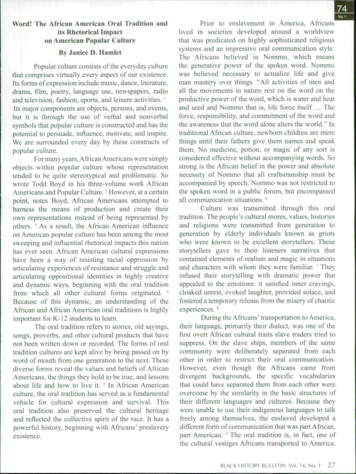
Transcription
Word! The African American Oral Tradition andits Rhetorical Impacton American Popular CultureBy Janice D. HamletPopular culture consists of the everyday culturethat comprises virtually every aspect of our existence.Its fonns of expression include music, dance, literature,drama, film, poetry, language use, newspapers, radioand television, fashion, sports, and leisure activities. 'Its major components are objects, persons, and events,but it is through the use of verbal and nonverbalsymbols that popular culture is constructed and has thepotential to persuade, influence, motivate, and inspire.We are surrounded every day by these constructs ofpopular culture.For many years, African Americans were simplyobjects within popular culture whose representationtended to be quite stereotypical and problematic. Sowrote Todd Boyd in his three-volume work AfricanAmericans and Popular Culture. - However, at a certainpoint, notes Boyd, African Americans attempted toharness the means of production and create theirown representations instead of being represented byothers. ' As a result, the African American influenceon American popular culture has been among the mostsweeping and influential rhetorical impacts this nationhas ever seen. African American cultural expressionshave been a way of resisting racial oppression byarticulating experiences of resistance and struggle andarticulating oppositional identities in highly creativeand dynamic ways, beginning with the oral traditionfrom which all other cultural forms originated. Because of this dynamic, an understanding of theAfrican and African American oral traditions is highlyimportant for K-12 students to learn.The oral tradition refers to stories, old sayings,songs, proverbs, and other cultural products that havenot been written down or recorded. The forms of oraltradition cultures are kept alive by being passed on byword of mouth from one generation to the next. Thesediverse forms reveal the values and beliefs of AfricanAmericans, the things they hold to be true, and lessonsabout life and how to live it. ' In African Americanculture, the oral tradition has served as a fundamentalvehicle for cultural expression and survival. Thisoral tradition also preserved the cultural heritageand reflected the collective spirit of the race. It has apowerful history, beginning with Africans' preslaveryexistence.Prior to enslavement in America, Africanslived in societies developed around a worldviewthat was predicated on highly sophisticated religioussystems and an impressive oral communication style.The Africans believed in Nommo, which meansthe generative power of the spoken word. Nommowas believed necessary to actualize life and giveman mastery over things. "All activities of men andall the movements in nature rest on the word on theproductive power of the word, which is water and heatand seed and Nommo that is, life force itself . Theforce, responsibility, and commitment of the word andthe awareness that the word alone alters the world." Intraditional African culture, newborn children are merethings until their fathers give them names and speakthem. No medicine, potion, or magic of any sort isconsidered effective without accompanying words. Sostrong is the African belief in the power and absolutenecessity of Nommo that all craftsmanship must beaccompanied by speech. Nommo was not restricted tothe spoken word in a public forum, but encompassedall communication situations. ''Culture was transmitted through this oraltradition. The people's cultural mores, values, historiesand religions were transmitted from generation togeneration by elderly individuals known as griotswho were known to be excellent storytellers. Thesestorytellers gave to their listeners narratives thatcontained elements of realism and magic in situationsand characters with whom they were familiar. ' Theyinfused their storytelling with dramatic power thatappealed to the emotions: it satisfied inner cravings,cloaked unrest, evoked laughter, provided solace, andfostered a temporary release from the misery of chaoticexperiences. **During the Africans' transportation to America,their language, primarily their dialect, was one of thefirst overt African cultural traits slave traders tried tosuppress. On the slave ships, members of the samecommunity were deliberately separated from eachother in order to restrict their oral communication.However, even though the Africans came fromdivergent backgrounds, the specific vocabulariesthat could have separated them from each other wereovercome by the similarity in the basic structures oftheir different languages and cultures. Because theywere unable to use their indigenous languages to talkfreely among themselves, the enslaved developed adifferent form of communication that was part African,part American. '' The oral tradition is, in fact, one ofthe cultural vestiges Africans transported to America.BLACK HISTORY BULLETIN Vol. 74, No. 127
1This orality was a communication style that was richin allusion, metaphor, and imagery and prolific in theuse of body gestures and nonverbal nuances. Also, thecommunication pattems of the enslaved stemmed fromtheir creativity and will to survive. Language becamenot only a means of communication but also a desire forpersonal presentation, verbal artistry, and commentaryon life's circumstances. '"From this rich legacy, the belief in andapplication of Nommo continues to permeate all aspectsof African American life and culture. The musicalexpressions of African Americans and the Black churchhave been the most significant forces in maintainingand nurturing the surviving African/African Americanlanguage and cultural traditions. Over the centuries,the church has stood as a rich reservoir of culturalterms and expressions communicated through thesermons of the African American preacher as wellas the feedback the preachers received from theiraudiences. " Known as call-and-response, this verbalexchange is based on the idea that constant exchangebetween speaker and listener is necessary in order forany real communication to take place between speakerand listener. Call-and-response is a spontaneous verbaland nonverbal interaction between speaker and listenerin which the speaker's statements are punctuated byresponses from the listener(s). '- Although the practicehas been ritualized in traditional Black churches, itcan also be observed outside of the church, from theacademic classroom to comedy, rap, and rhythm andblues concerts. The only wrong response one can givein a conversation between African Americans is to notrespond at all. The hip-hop expressions word, word up,word to the mother, and similar phrases all stem fromthe value placed on speech and verbal artistry.Through various processes, African Americansstake their claim to the English language and at thesame time reflect distinct African American culturalvalues that are often at odds with Eurocentric standards.For example, "semantic inversion," the practice oftaking words and tuming them into their opposites,has become an art form for young African Americanartists. An example of this is the word fat. In hip-hopculture, it is spelled phat and refers to a person or thingthat is excellent and desirable, reflecting the traditionalcultural value that human body weight is a good thingand implicitly rejecting the Eurocentric thought whichteaches that being skinny is more valued than being fat." Other aspects of the African American oral tradition(i.e., testifyin', signifyin', and trash talkin') have foundtheir way into mainstream American popular culture. '''Equally significant, musical expressions have28BLACK HISTORY BULLETIN VoL 74, No. 1been an art form for African Americans that allowed,both historically and contemporaneously, creativity,thought, and imagination to be widely demonstrated.Music can be cathartic for both its makers and itslisteners, as stories of adversity and struggle areoften expressed. Much can be leamed about thehistory of African Americans through the music ofspirituals, blues, gospel, jazz, and hip-hop. In themusic are emotional stories of the hardship, hope, anddetermination of a people who have been downtroddenand oppressed. The messages sent through musicreflect the different social and cultural values of anygiven time period. "Nommo can especially be observed today inhip-hop culture, particularly in rap music.According to Tricia Rose in her book Black Noise, theemergence of hip-hop culture came about as the resultof cultural exchange and larger social and politicalconditions of black alienation and disillusionment.The African American, particularly the Black youth,sought identity and a way to stake a claim in his ownculture. Hip-hop became that means, and a new systemof values developed that allowed the African Americanan outlet for self-expression and creativity. Rap is aninteresting venue because it is fundamentally linkedto the social constructions of black culture. "' Hip-hop
culture has permeated mainstream popular culture inan unprecedented fashion. Although it was created byblack youth operating on the periphery of mainstreamAmerican culture, hip-hop's influence has now becomeworldwide, dominating the advertising and marketingworlds as well as academia and corporate boardrooms.Its crossover appeal has become phenomenal acrossethnic groups with the potential to unify diversepopulations.Notes1. J. K. Adajaye, "Popular Culture and the BlackExperience," m Language, Rhythm and Sound: BlackPopular Cultures Into the Twenty-First Centuir, ed.Joseph K. Adajaye and Adrianne R. Andrews (Pittsburgh, PA: University of Pittsburgh Press, 1997),1-15.Janice D. Hamlet is an Associate Professor of Communication at Northern Illinois University.She teaches courses in rhetorical theory and criticismand culture and communication.2. Todd Boyd, African Americans and Popular Culture(Westport, CT: Praeger Press, 2008), viixiii.3. Ibid.4. "Black Popular Culture," Black-Popular-Culture.html.5. Geneva Smitherman, Black Talk: Words andPhrases from the Hood to the Amen Comer (NewYork: Houghton MifPlin, 1994), 29.6. Arthur L. Smith, "Socio-Historical Perspectives ofBlack Oratory," in Language, Communication, andRhetoric in Black America, ed. Arthur L. Smith (NewYork: Harper and Row. 1972), 295-305.7. Ibid.8. Ibid.9. Geneva Gay and Willie L. Baber, eds. Expressively Black (New York: Praeger, 1989).10.Ibid.11. Smitherman, Black Talk.12. Ibid.13. Ibid.14. Allison Ashley, "Black Popular Culture and ItsMessages," accessed March 20, 2011, ck popularculture and its messages.html?cat 33.15. Tricia Rose, Black Noise: Rap Music and BlackCulture in Contemporary America (Hanover, NH:university Press of New England, 1994).16. Ashley, "Black Popular Culture."BLACK HISTORY BULLETIN Vol. 74, No. 129
Lesson PlanWord! The African American Oral Tradition and Its Rhetorical Impacton American Popular CultureBy Janice D. HamletConnections to Secondary StudentsSecondary school students are at an age where making connections between the present and the past is a necessarypart of critical engagement and personal growth. Seeing how past practices are intimately tied to contemporarypractices encourages students to look to the past for understanding and inspiration. In the case of this topicand lesson, helping students understand that the oral tradition is an indelible part of African American cultureencourages a renegotiation of assumptions about African Americans.Objectives To introduce students to the African American oral tradition, beginning with pre-slavery and continuing tocontemporary life. To familiarize the students with various cultural products that originated from the African American oral tradition.Goals Students will gain an understanding of the African American oral tradition. Students will demonstrate their knowledge through the creation of products that focus on cultural productsthat emanated from the oral tradition, such as rap songs, spirituals, dances, sermons from the African Americanchurch, folklore, etc. Students will demonstrate using new media to communicate ideas. Students will analyze the role of culture within their own lives and communities.NCSS StandardsIndividuals, Groups, and Institutions Help learners analyze group and institutional influences on people, events, and elements of culture in bothhistorical and contemporary settings.Culture and Cultural Diversity Enable learners to analyze and explain the ways groups, societies, and cultures address human needs andconcerns; Guide learners as they predict how data and experiences may be interpreted by people from diverse culturalperspectives and frames of reference; Assist learners to apply an understanding of culture as an integrated whole that explains the functions andinteractions of language, literature, the arts, traditions, beliefs and values, and behavior patterns.30BLACK HISTORY BULLETIN Vol. 74, No. 1
Warm-Up/Anticipatory Set Begin by activating students' knowledge of African American history and culture as it relates to the AfricanAmerican oral tradition and its contemporary communication pattems. Assign each student to a group. The assignment will be to research and report on an area of African Americancommunication and share with the class the report as well as examples of this type of communication. Topicsmight include the blues, gospel music, jazz, poetry, word artistry, rap, storytelling, or communicating nonverballythrough dance. These should be introductory presentations, simply to provide all students a level of exposure tothe breadth of ways in which the oral tradition can be seen historically and contemporarily. Students should be encouraged to demonstrate an example ofthe oral tradition that emanates from their topic. Each report should reveal the influence ofthe African/African American oral tradition in creating this form ofcommuni
(i.e., testifyin', signifyin', and trash talkin') have found their way into mainstream American popular culture. ''' Equally significant, musical expressions have been an art form for African Americans that allowed, both historically and contemporaneously, creativity, thought, and imagination to
